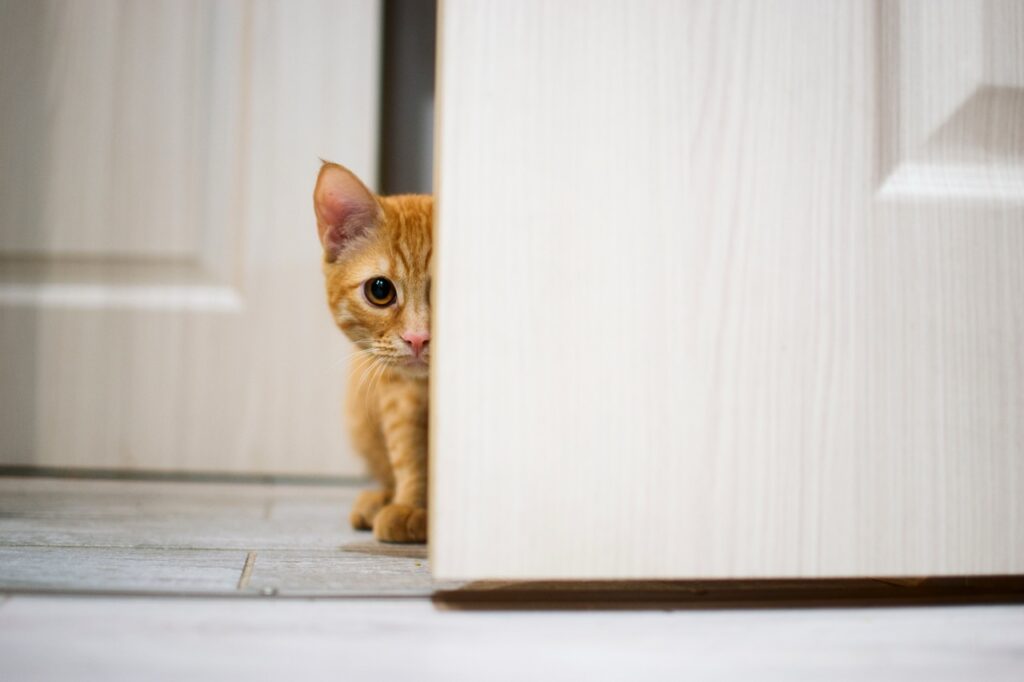How to Introduce Your New Cat to the Rest of the House – Beyond the Safe Room
This article is part of our series on how to acclimate your new cat to give it the best start possible.
Our focus in this article is how to gradually introduce a new cat to the rest of your home, after the initial adjustment period in the cat safe room.
Why should you do this rather than just setting your cat free to explore everywhere all at once? There are very good reasons actually…
If you do it systematically, you increase the chances that the cat will have positive associations – and feelings of security – with each room in your home.
And a cat that feels secure is a cat more likely to be confident and affectionate with its humans. And that’s the very foundation for a cat that forms a strong bond with you. Trust us, you want that!
We’ll start with a brief overview of cat-proofing and using a safe room.

Before You Bring Your Cat Home: You Gotta Cat-Proof Everything and Set Up a Safe Room
Think like a cat when preparing your home. Cats have strong impulses to explore every height, surface, nook, and cranny, so check and secure both low and high spaces.
See our guide to cat-proofing for the full rundown. Here are some examples of common high-priority items to address.
Remove Common Hazards
- Secure or remove loose wires and cords that could be chewed or cause entanglement
- Install and fasten sturdy window screens to prevent falls and escapes
- Store chemicals and medications in locked cabinets
- Remove toxic plants or place them in inaccessible areas
- Hide small objects (rubber bands, hair ties, strings) that could be swallowed
- Install childproof latches on cabinets containing hazardous items
- Secure trash cans with locking lids to prevent curious paw investigations
For detailed guidance, you can refer to each of our focused cat-proofing articles:
- Curtains
- Electrical Cords
- Kitchen
- Bathroom
- Common Toxins
- Cat-Proofing Your Own Habits for Your Cat’s Safety
Create a Safe Room
Choose a quiet room away from household traffic – this will be your cat’s sanctuary during the adjustment period. Here they will have the chance to feel secure while slowly getting used to the sounds and smells of their new home.
The basic safe-room setup includes these essentials:
- Litter box (placed far from food area)
- Food and water bowls
- Cozy bed or blanket
- Scratching post
- Few simple toys
- Cardboard box or cat cave for hiding when feeling overwhelmed
Read our Guide to Using a Safe Room for full information on how to set things up and use the room for optimal acclimation.
Beyond the Safe Room – A Step-by-Step Exploration Process
Introduction to Each Room
Introducing a new cat to different rooms requires patience and careful planning. A gradual, supervised approach allows the cat to explore safely while becoming comfortable with new spaces and objects.
Gradual Exploration
Start by allowing the cat to explore just one room at a time if possible. Keep initial sessions short – perhaps 5-10 minutes in the beginning. Then make subsequent sessions longer if things have gone well.
Signs Your Cat is Ready to Explore
Your cat should feel completely comfortable in their safe room before venturing further.
Here are some of the signs your cat is adjusting that show they’re ready to explore beyond the safe room:
- Using litter box consistently without accidents
- Eating and drinking normally
- Coming out to greet you instead of hiding
- Playing with toys or showing interest in play
- Relaxed body language – tail up, ears forward
When you’re introducing new spaces, choose a time when things are the most calm and quiet in your home.
Try to minimize what’s new for the cat to just the room itself. For example, don’t introduce new people or pets at the same time. And don’t have unnecessary appliances or devices turned on.
For example, you shouldn’t be running the coffee grinder or dishwasher, and you shouldn’t have the stereo or TV on. You can introduce those things in small doses after your cat has become comfortable being in the room when things are still and quiet.
This helps prevent overwhelming the cat with too much new information at once.
Leave the door open so the cat can retreat to its safe space if needed. Place familiar items like toys, a blanket, or a scratcher in the new room.
Allow the cat to set its own pace. Some cats may take hours or even days to fully explore a new space, while others may be more adventurous.
Supervised Explorations
Always supervise the cat during initial explorations of new rooms. This allows you to observe behavior and provide verbal reassurances and treats.
Watch for signs of stress or anxiety, such as hiding, excessive meowing, or flattened ears. If the cat appears to be too stressed out, calmly end the session and try again later.
In that case, try to coax or guide the cat back to the safe room – this is preferable to suddenly picking the cat up in your arms, especially for a cat who isn’t used to being picked up yet.
It’s normal for a cat to show at least some signs of stress during this process. But hiding or freezing in one place is a clear sign of overwhelm. If there are moderate stress signals combined with a curiosity to explore, you might allow the session to continue, but keep it brief.
Watch Your Cat’s Body Language
These are signs of stress:
- Flattened ears pressed against head
- Crouched posture close to ground
- Hiding or attempting to hide
- Excessive meowing or vocalizing
- Tail tucked under rather than held up
Encourage positive associations by using treats and soft verbal praises and reassurances.
What to do About Setbacks
If there are setbacks, you may need to modify the next session in some way. This might be allowing access to less space, making the session shorter, or using treats more methodically.
If the cat gets spooked by an object or noise, you’ll probably need to spend some time desensitizing (helping the cat feel safe around that thing through gradual exposure and use of positive reinforcement).
Interacting with Room-Specific Features
Each room presents unique features for a cat to investigate. You must cat-proof each room before letting your cat explore it.
Refer to our cat-proofing articles for detailed guidance.
Spotlight on Building Confidence and Sense of Security
Building a cat’s confidence and feelings of trust and security in a new home environment is huge for their well-being and happiness.
You can optimize this process by using familiar scents, positive reinforcement, and gradual exposure to new stimuli.
Affiliate Disclosure: VerveCat is supported by readers. As a member of Amazon Associates and other affiliate programs, we may earn a commission at no added cost to you when you follow a product link and make a purchase.
Using Scent Markers
Cats rely heavily on their sense of smell to navigate their environment. Providing familiar scents can help a new cat feel more at ease.
Place items with the cat’s scent, such as bedding or scratchers, in different rooms of the house.
Many people also swear by using synthetic feline pheromones to create a calming atmosphere. These mimic the natural scents cats use to mark their territory and signal calm.
Encourage your cat to spread its scent by providing scratching posts and allowing it to rub against furniture. These scent marking behaviors are used to mark territory and establish a sense of security.
Positive Reinforcement
We recommend all cat owners learn about positive reinforcement and how to use the techniques in training and shaping desirable behaviors.
Reward your cat with treats, praise, or gentle petting when it explores new areas or displays brave or desired behavior.
If the cat is feeling comfortable enough, you can try using interactive toys to engage the cat in play sessions once it has investigated the room. This creates positive associations with new spaces and encourages further exploration.
Avoid forcing interactions or punishing the cat for timid behavior. Instead, let the cat set the pace for exploration and socialization.
Adapting to New Scents and Sounds
Gradually introduce the cat to new scents and sounds in the home. Start with low-intensity stimuli and slowly increase exposure as the cat becomes more comfortable.
Sometimes it’s possible to use white noise machines or soft background music to mask unfamiliar sounds that might startle or stress the cat.
Some cats, like my Phoebe, are afraid of the TV. Gradual introductions can help here too.
Start with no or low volume, and some peaceful content. The thing that seems to get Phoebe the most is when people on screen are up close or moving toward the camera.
Things that Seem Weird or Scary to Cats
Things that move unpredictably or make a lot of noise may also require systematic and gradual desensitization. You can begin by giving food or treats while the new thing is activated or turned on in the distance.
This allows the cat to hear or see it while far from it and while something good is happening (getting a treat).
In addition to the TV, other examples include the vacuum cleaner, kitchen appliances, rolling chairs, exercise balls, etc.
Add Rooms Gradually, One at a Time
Think of this like introducing someone to spicy food – start mild and work up slowly.
Many people simply place the cat in their home and let it go wherever it wants right away. But this is a recipe for sensory overload and overwhelm.
Rushing the process risks stress and potential long-term negative associations or feelings of insecurity with parts of your home.
Instead, you want to introduce new areas of the home systematically – in small, controlled, and supervised doses.
Start with just one room next to the safe room, and do multiple short sessions over a couple days.
You want them showing signs of comfort and confidence in that room before you move on to another new room. Some rooms may take more days/sessions than others.
This takes patience and discipline because, let’s face it, you want your new cat to see the whole house! But it’s worth it to go slow and you only get one shot at it.
Last Meows
The journey from new cat to confident family member requires patience and understanding:
- Never force exploration – anxiety creates negative associations
- Always supervise initial visits to new rooms
- Reward calm, confident behavior with treats and gentle praise
- Maintain the safe room as a retreat space even after adjustment
- Be patient – most cats take at least a few weeks to feel fully comfortable
Trust your cat’s pace. A slow, careful introduction leads to a confident, secure cat who feels truly at home. And that’s the foundation you want for a strong bond with your cat.
